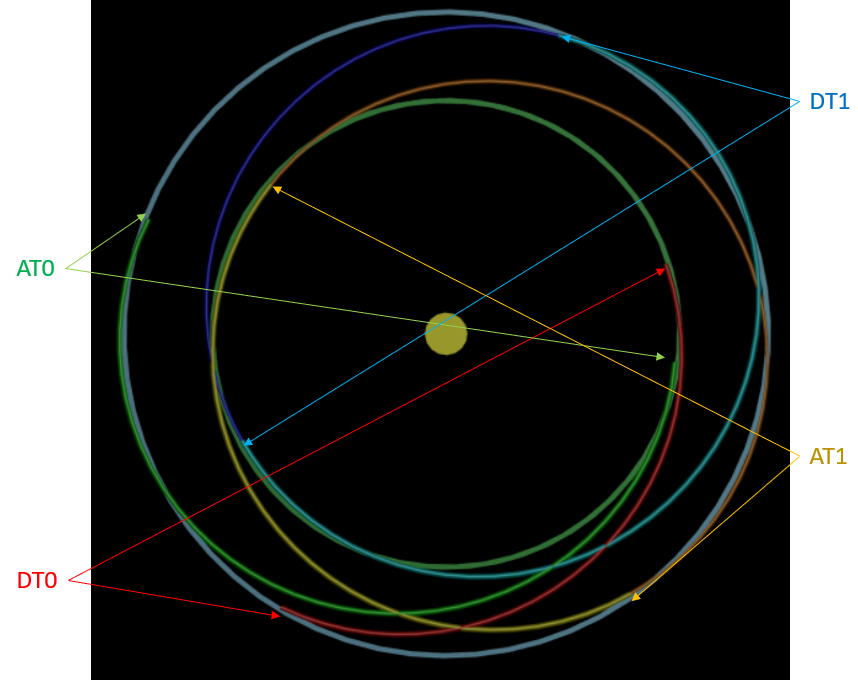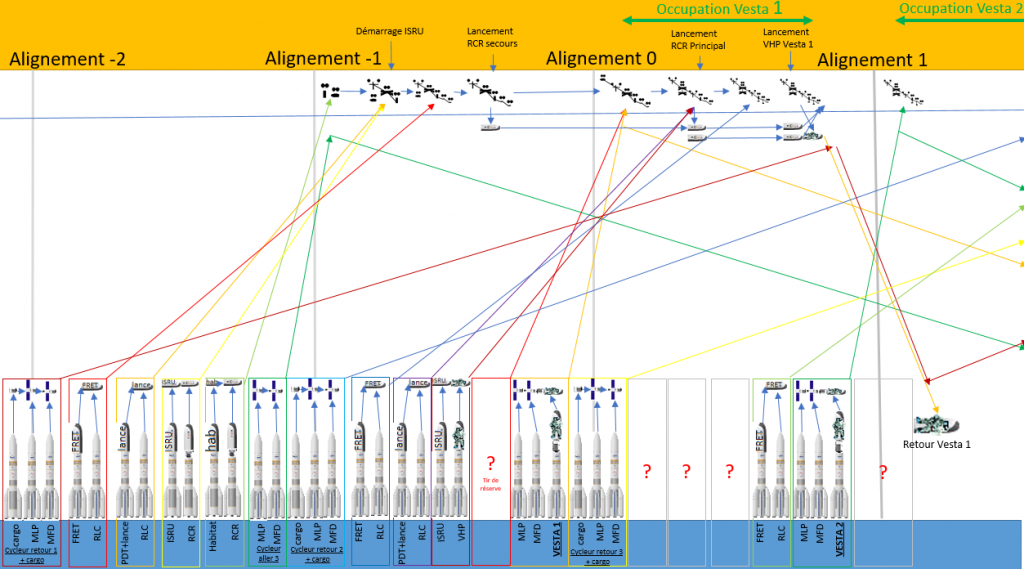This chapter presents a schedule for a first mission in a minimum time. This delay can be lengthened to space the shots. As mentioned above, the T0 moment is defined as the Earth-Venus-Sun alignment during the first crew. mission. To these missions will have to be added (in advance of the project) a robotic reconnaissance and relay installation program communication around Venus, as well as a programme for the development of elements cited in the 3rd, including the MMV and the Venusian launcher.
3.1. window
Not all launches will be like usually during a direct window by varying the parameters of the transfer orbit. In order to space the launches to the best of their ability, the same orbit (which allows you to keep the same Delta-V) that will be used for all transfers, but not just in direct fire. These are the most a total of 6 different trajectories.
- Direct travel (DT0) departure 57.3 days before alignment, arrival 52.25 days after alignment.
It’s the shot. preferred for manned flights, it consists of making a direct journey from Earth to Venus in 109 days.
- Aphelia travel (AT0) departure 138.4 days before alignment, arrival 40 days after alignment.
Instead of being launched to Venus, the payload is sent to the aphelia and then intersects Earth’s orbit before waiting for Venus. This journey is much longer than direct shooting (180 days) but allows you to have a shot 80 days before the DT0 and arrive about ten days before.
- departure 250.5 days before the line-up, 158 days after the line-up.
The payload is launched towards the perihelion as if for a direct shot, but it makes a full orbit before to join Venus. Even if this maneuver greatly lengthens the journey (which excludes manned flight), it allows to perform (with the same Delta-V), firing 110 days before the TA0 and thus space the shots across the entire alignment instead of focus around the direct shooting window.
- Aphelia Travel 1 (AT1) departure 331.6 days before the line-up, arrival 145.7 days after the alignment.
The shooting is carried out to the aphelia and makes a full orbit before reaching Venus. Always for the purpose of reading the activity of the no shots, this journey requires 80 days before TD1.
- Direct travel 2 (DT2) departure 443.7 days before the line-up, arriving 264 days after the alignment.
Identical route DT1 but makes two waiting orbits instead of one.
- Cycler Return Travel (CRT): departure 57.3 days after alignment, arrival 52.25 days before alignment 3.
It’s a ride which allows the return cycler to be launched.

3.2. Vesta Planning 1
The factor determining the time to prepare for the first mission is the launch of the cycler back. Indeed, it will have to pass 3 alignments in orbit waiting before they can retrieve the crew from the edge of Venus to bring them back to the Earth. This launch (on the route called CRT) triples (two launchers for the cycler plus one for the cargo ship) will therefore have to be done at the -2 alignment (the return alignment 1).
Them trajectories around the -1 alignment will be devoted to the implementation of The base. The AT0 is the first to arrive on Venus, it will carry habitat that will be the first to make a Venusian re-entry because in case failure this will bring lessons to the more expensive elements. The journeys DT1 and AT1 will be dedicated to sending the launch system, which will therefore be active at the earliest and will be able to place the emergency RCT into orbit before the the crew of Vesta 1, which will be postponed in the event of failure. Even if it’s the first to depart, the DT2 is the last one to arrive, so it carries the useless cargo without crew. In addition, DT0 and CRT routes will be dedicated to launch of the cyclers go for Vesta 3 and return for Vesta 2.
Alignment 0 will, of course, culminate in the DT0, with the launch by pair of the vesta 1 cycler and the simple launch that will send the cargo ship and especially the MMV carrying the Vesta 1 crew. The AT0 will be booked launching a possible module lost in a previous window. Them DT1 and AT1 routes will be dedicated to the secondary launch system and the emergency MMV, in place of a RCT (Arianes 6.4 will be used to compensate for the performance differential). The TD2 will be dedicated to preparations for Vesta 2.
In addition to the Return of Vesta 1 and the departure of Vesta 2, the 1 alignment offers many free journeys to give Vesta 3 a boost and move from exploration to the occupation.
It is worth noting that from Vesta 4, it will no longer be necessary to launch a new cycler. Vesta 4 will use the Vesta 1 cycler, Vesta 5 the Vesta 2 cycler, and so right away. However, additional modules can be added to increase the size of the crew.
| Departure Earth | Arrival Venus | |||||||
| Alig | Days | T0 | Alig | Days | Launch | Cu | Note | |
| CRT | -2 | 57,3 | -1111 | 1 | -52,3 | LP6.4-LS6.2 | Return Cycler 1 cargo | Cycler who will bring back Vesta 1 |
| DT2 | -1 | -444,0 | -1028 | -1 | 263,4 | LP6.4 | 2 freight modules | Freight and experiences for Vesta 1 |
| AT1 | -1 | -332,0 | -916 | -1 | 146,0 | LP6.2 | ISRU – RCT | Main launch system |
| DT1 | -1 | -251,0 | -835 | -1 | 158,0 | LP6.4 | launcher | |
| AT0 | -1 | -138,0 | -722 | -1 | 40,0 | LP6.2 | Habitat – RCT (rescue) | |
| DT0 | -1 | -57,3 | -641 | -1 | 52,3 | LP6.4 | Cycler go 3 | Cycler who will take Vesta 3 |
| CRT | -1 | 57,3 | -527 | 2 | -52,3 | LP6.4-LS6.2 | Return Cycler 2 – cargo | Cycler who will bring back Vesta 2 |
| DT2 | 0 | -444,0 | -444 | 0 | 263,4 | LP6.4 | 2 freight modules | Freight and experiences for Vesta 2 |
| AT1 | 0 | -332,0 | -332 | 0 | 146,0 | LP6.4 | ISRU – MMV | System emergency launch LP6.4 replaces LP6.2 for ISRU-VHP to compensate for the lack of power of the VHP |
| DT1 | 0 | -251,0 | -251 | 0 | 158,0 | LP6.4 | launcher | |
| AT0 | 0 | -138,0 | -138 | 0 | 40,0 | ??? | Free | In case failure of a previous shot |
| DT0 | 0 | -57,3 | -57 | 0 | 52,3 | LP6.4-LS6.4 | cycler go 1 – cargo – MMV | Launch of Vesta 1 – its cycler |
| CRT | 0 | 57,3 | 57 | 3 | -52,3 | LP6.4-LS6.2 | Cycler return 3 – cargo | Cycler who will bring back Vesta 3 |
| DT2 | 1 | -444,0 | 140 | 1 | 263,4 | ??? | Free | |
| AT1 | 1 | -332,0 | 252 | 1 | 146,0 | ??? | Free | |
| DT1 | 1 | -251,0 | 333 | 1 | 158,0 | ??? | Free | |
| AT0 | 1 | -138,0 | 446 | 1 | 40,0 | LP6.4 | 2 freight modules | Freight and experiences for Vesta 3 |
| DT0 | 1 | -57,3 | 527 | 1 | 52,3 | LP6.4-LS6.4 | cycler go 2 – cargo – MMV | Launch of Vesta 2 |
| CRT | 1 | 57,3 | 641 | 4 | -52,3 | ??? | Free | Return of Vesta 1 |
Over this 4-year period and 10 months, the distribution of launches will be:
Setting up Venusian base: 6 launches (4 Ariane 6.2 – 2 Ariane 6.4)
Setting up 2 cyclers: 4 launches (4 Ariane 6.4) / mission (reusable every 3 alignments)
Setting up emergency systems: 4 launches (4 Ariane 6.4)
Launch manned mission (MMV – 2 cargo ships 2 freights): 4 launches (3 Ariane 6.4 – 1 Ariane 6.2)
As long as the crew is on Venus, it is not in danger of death because it has food for multiple alignments. The presence of a system of relief is therefore reassuring, but not essential, its launch is therefore subject to the financial capabilities of the programme. Two minimum cyclers are required for a mission, but these two only cyclers can be used every three alignments (about 5 years). If there is a desire to increase the pace (as in the schedule presented), it is will need to send two more pairs of cyclers.
Finally, the minimum number of Vesta 1 launches is 14 shots (Venusian base – 2 cyclers – mission inhabited). For Vesta 2, this number ranges from 4 launches for a 5 years after Vesta 1, at 12 if the mission leaves before the Vesta 1 and incorporates a launch system Rescue.
This number of shots may sound impressive, but keep in mind that martian mission projects (semi-direct Mars type) require 4 to 6 launchers SLS at least 6 times more powerful than Ariane 6. In addition, they are launchers they have a cost per kg well below the SLS and such a large amount of scale allows for significant economies of scale and replaces subsidies to launch operators by guaranteeing a large number of shots. Finally, if you make a mass equivalence in low orbit (20 t/Ariane 6.4), we are close to the ISS programme (ATV, HTV and Progress including) between 2006 and 2011 (return to flight of the shuttle) when the bulk of the launches were made by the space shuttle at an exorbitant cost. Since the travel are 80 to 120 days and the launches are double or triple, it is will need to maintain a pace of one launch every 40 days for at least 4 years. This rate could saturate facilities such as the space center Guiana. To avoid this there are several solutions:
– An extension of preparations on several additional alignments.
– The construction of a second Ariane launch package in Kourou in order to keep business activities in parallel.
– One international partnership with the USA (Delta IV, Atlas 5, Vulcan, Falcon Heavy reused or Falcon 9 consumable to replace an Ariane 6.2), Russia (Proton, Angara 5, Soyuz5.3), Japan (H3 only in place of an Ariane 6.2) China (CZ-5) or India (launcher to be developed) to distribute Shots.
– The use of heavy launchers (Falcon type Heavy consumable, New Glenn, CZ-9 or developed for the occasion) replacing the paired launches.

